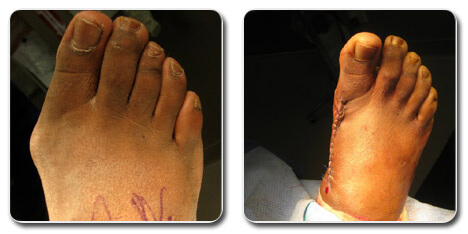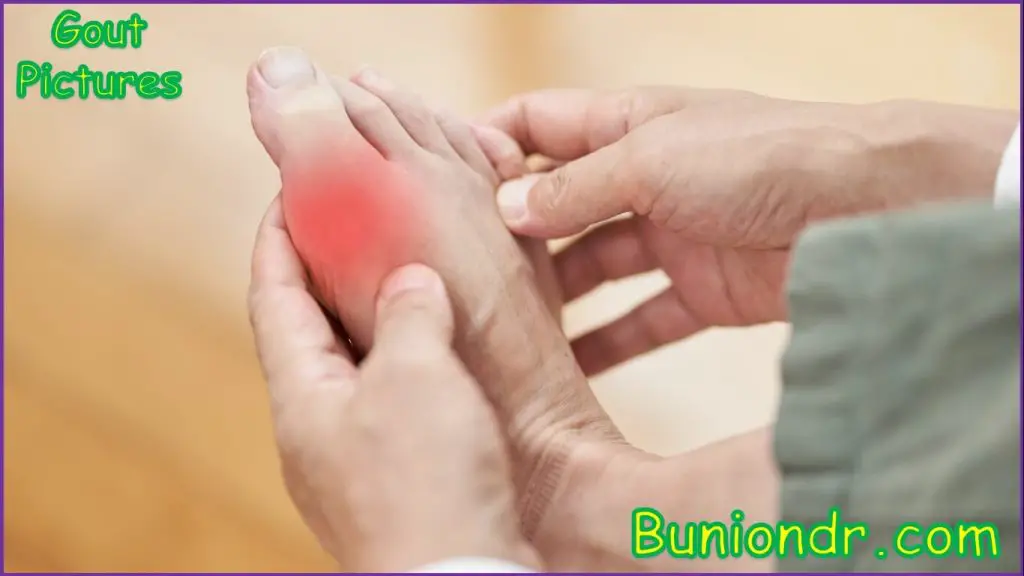Gout vs Bunion: The Difference Between Gout and Bunion?
Bunions and gout are two commonly experienced foot conditions that are capable of inducing severe discomfort and pain. Despite bearing comparable symptoms, the two conditions differ in terms of causes and treatment modalities.
A bunion refers to a bony protrusion that develops on the joint connecting the foot to the big toe. The misalignment of the big toe causes it to bend towards other toes, leading to discomfort and pain during ambulation. Conversely, gout constitutes a type of arthritis characterized by joint inflammation and pain resulting from uric acid crystal accumulation in the joints.
Comprehending the differences between bunions and gout is crucial for the correct diagnosis and treatment. While the two conditions can produce analogous symptoms, underlying factors and treatment approaches are distinct. Misdiagnosis can result in ineffective treatment and prolonged discomfort.
What Exactly Is A Bunion?
Bunions occur when the joint connecting the big toe to the foot becomes misaligned, which bends the big toe towards other toes. Over time, the bone protrudes, causing the formation of a bony bump. Bunions occur more frequently in women and can arise from wearing tight or ill-fitting shoes, genetic inheritance, arthritis, and particular medical conditions such as polio or cerebral palsy.
Indicators of bunions include pain, inflammation, and tenderness around the base of the big toe, visible bump on the side of the foot, redness, and restricted motion of the big toe. Treatment options for bunions include wearing shoes that fit comfortably, using orthotic shoe pads or inserts, taking over-the-counter painkillers such as ibuprofen, and in severe cases, surgical intervention.
What Is Gout?
Gout refers to a type of arthritis arising from the accumulation of uric acid in the body. Uric acid is a by-product that is typically excreted via urine. However, the body’s excessive production of uric acid or improper elimination by the kidneys leads to its accumulation in the joints, leading to inflammation and pain.
Gout is characterized by abrupt and severe pain, inflammation, and redness in the joints. The condition can arise from various factors, such as genetic inheritance, obesity, hypertension, and some medications. However, the primary cause of gout is the accumulation of uric acid in the body.
Symptoms of gout frequently occur suddenly, lasting for days or weeks. They encompass intense pain, swelling, and redness in the affected joint, accompanied by warmth and stiffness.
There are several treatment approaches for gout, including anti-inflammatory and pain-relieving medications and lifestyle modifications such as exercise, dietary modifications, and weight loss.
Gout vs Bunion: The Difference Between Gout And Bunion?
Although both conditions can lead to joint pain and inflammation, significant differences exist between bunions and gout.
Bunion vs Gout: Location
Bunions mainly affect the big toe joint, while gout can affect any joint in the body.
Gout vs Bunion: Causes
Bunions result from a combination of environmental and genetic factors, while gout primarily results from uric acid accumulation in the body.
Bunion vs Gout: Symptoms
Bunions are characterized by a bony bump on the side of the foot, while gout causes sudden and severe pain, inflammation, and redness in the affected joint.
Gout vs Bunion: Treatment
Bunion treatment frequently comprises lifestyle changes such as wearing comfortable shoes and using orthotic shoe pads or inserts. In contrast, gout treatment incorporates anti-inflammatory and pain-relieving medications and lifestyle modifications such as exercise, dietary adjustments, and weight loss.
Bunion Or Gout: How Do I Know If it’s A Bunion Or Gout?
Check this comparison table between bunions and gout:
| Feature | Gout | Bunions |
|---|---|---|
| Definition | Gout is a type of arthritis characterized by the sudden and severe onset of joint pain, often in the big toe, due to the accumulation of uric acid crystals in the joints. | Bunions are bony bumps that form at the base of the big toe, causing the big toe to deviate towards the other toes. |
| Causes | Gout is primarily caused by the buildup of uric acid in the bloodstream, leading to the formation of urate crystals in the joints. This can be due to genetics, diet, and other factors. | Bunions are often caused by wearing tight or ill-fitting shoes, which can force the big toe to bend towards the other toes over time. Genetics can also play a role. |
| Symptoms | Symptoms of gout include sudden and intense joint pain, swelling, redness, and warmth in the affected joint (commonly the big toe). Gout attacks can be recurrent. | Bunions may cause pain and discomfort at the base of the big toe, as well as swelling and a noticeable bump. They can also lead to difficulty in finding comfortable footwear. |
| Location | Gout typically affects one or a few joints at a time, often the big toe joint, but it can also affect the ankles, knees, wrists, and fingers. | Bunions occur specifically at the base of the big toe, where the metatarsophalangeal joint is located. |
| Risk Factors | Risk factors for gout include a diet high in purines (found in red meat and certain seafood), alcohol consumption, family history, obesity, and certain medications. | Risk factors for bunions include genetics (family history), wearing tight or high-heeled shoes, and having certain foot conditions or deformities. |
| Diagnosis | Gout is usually diagnosed through a combination of a physical examination, blood tests to measure uric acid levels, and joint fluid analysis to check for urate crystals. | Bunions can be diagnosed through a physical examination of the foot and an evaluation of the foot's structure. X-rays may also be used to assess the severity. |
| Treatment | Gout is typically managed with medications to relieve pain and inflammation (NSAIDs or colchicine) and drugs to lower uric acid levels (allopurinol). Lifestyle changes and dietary modifications are also important. | Treatment for bunions may include wearing wider shoes, using orthotic devices, applying padding, or taking over-the-counter pain relievers. In severe cases, surgery to remove the bunion may be recommended. |
| Prevention | Preventing gout involves maintaining a healthy diet, staying hydrated, limiting alcohol consumption, and managing underlying conditions that contribute to high uric acid levels. | Bunions can be prevented or their progression slowed by wearing well-fitting, comfortable shoes with a wide toe box and avoiding tight or high-heeled shoes. Genetic factors cannot be prevented. |
Tips For preventing Bunions And Gout
Although it may not be possible to completely prevent bunions and gout, there are some lifestyle changes you can make to reduce your risk of developing these conditions.
Lifestyle Changes
Maintaining a healthy weight, wearing comfortable shoes, and avoiding high heels and tight-fitting shoes can help prevent bunions. To prevent gout, reducing alcohol consumption and staying hydrated can help prevent uric acid from accumulating in your body.
Dietary Modifications
A diet high in purines, which are found in meat and seafood, can increase the risk of gout. Reducing your intake of these foods and increasing your intake of fruits, vegetables, and low-fat dairy products can help reduce the risk of gout.
Exercise Recommendations
Regular exercise can help prevent both bunions and gout by strengthening your muscles and joints, improving your overall health and well-being.
Conclusion [Gout vs Bunion]
In conclusion, bunions and gout are two distinct conditions with different causes, symptoms, and treatments. If you are experiencing joint pain or inflammation, it is important to seek medical advice as prompt diagnosis and treatment can help prevent complications and improve outcomes.
Bunions and gout can be effectively managed with lifestyle modifications and medical treatments. By taking steps to reduce your risk of developing these conditions, you can improve your overall health and well-being.
Can Gout Cause Bunions?
Gout itself doesn’t directly cause bunions, but there can be an indirect connection between the two. Gout is a type of arthritis triggered by the accumulation of uric acid crystals in joints, often affecting the big toe. Repeated gout attacks and persistent inflammation in the big toe joint can lead to changes in the joint’s structure over time. This altered joint function, coupled with genetic factors, can contribute to the development of bunions—a bony bump at the base of the big toe. So, while gout doesn’t directly cause bunions, it can be a factor in their formation due to its impact on joint health and function.
Can A Bunion Cause Gout?
A bunion itself doesn’t typically cause gout, but it can indirectly increase the risk of gout attacks in some cases. Bunions are primarily a structural issue, where a bony bump develops at the base of the big toe, often due to pressure from tight or ill-fitting shoes. However, bunions can alter the alignment and function of the affected joint, which may contribute to the development of gout if uric acid levels are already elevated in the body. The misalignment caused by bunions can create an environment where uric acid crystals are more likely to accumulate, potentially leading to gout symptoms. So, while bunions don’t directly cause gout, they can play a role in increasing the likelihood of gout attacks in some individuals.
FAQs About Gout vs Bunion:
Can you have bunions and gout at the same time?
While it is possible to have both conditions at the same time, it is relatively rare. Some symptoms of gout, such as swelling and pain, can mimic those of a bunion. It is important to see a healthcare provider to determine the correct diagnosis and treatment.
Is surgery the only treatment option for bunions and gout?
No, surgery is not always necessary for bunions and gout. In fact, many cases can be managed through non-surgical treatments such as lifestyle changes, medications, and physical therapy. Surgery is usually only recommended for severe cases that do not respond to conservative treatments.
Are bunions and gout hereditary?
Yes, both bunions and gout can be hereditary. Genetics may play a role in the development of these conditions, but lifestyle factors such as diet and exercise can also affect the risk of developing them.
Are there any natural remedies for bunions and gout?
Some natural remedies such as ice packs, rest, and certain supplements may help alleviate symptoms of bunions and gout. However, it is important to talk to a healthcare provider before trying any natural remedies, as they may interact with medications or have other potential risks.
Can bunions and gout be cured?
There is no definitive cure for bunions and gout, but they can be managed through proper treatment and lifestyle modifications. With appropriate care, many people with these conditions can live relatively pain-free lives and avoid serious complications.
Do you know someone who is suffering from foot pain? Share our article “Gout vs Bunion: The Difference Between Gout and Bunion?” with them to help them understand the key differences between these conditions and how to manage their symptoms. Let’s spread awareness about foot health and help others live a pain-free life!
See Also:
- What is The Difference Between a Corn and a Bunion?
- Simple Foot Treatments to Make Feet Beautiful & Pain-Free
- 3 Bunion Surgery Myths You Should Know
- Lapiplasty vs Bunionectomy – Which One is Better for Your Foot
- Why Do Some People Get Bunions?
- Best Sneakers for Ankle Support and Arch Support
- Bunion Pictures – Bunion Photo Gallery
- Busting the Bunions: 10 FAQs Answered
- Avoiding Problems After Bunion Surgery
- Factors to Consider: What Shoes Are Good for Bunions?
- Bump in between toes painful



Leave a Reply